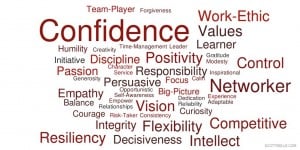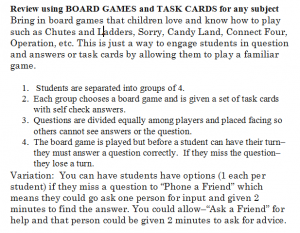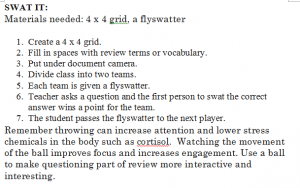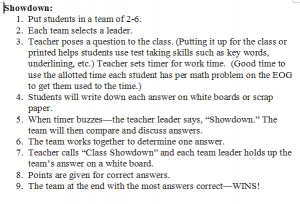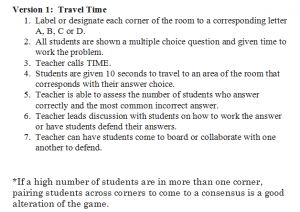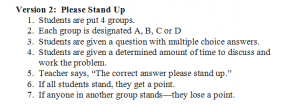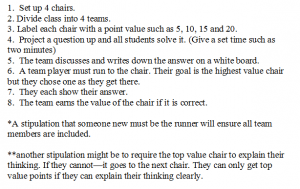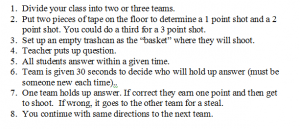With the testing season in full swing, we are reminded about the term STRESS! Stress is a growing part of our everyday lives for teachers and students. According to Stanford School of Medicine, the number of children, ages of 7-17, treated for depression has more than doubled between the years of 1995 and 2001. Based on a report from the National Institute of Mental Health in 2014, “11.4% of population or 2.8 million adolescents, ages 12-17, have reported a major depressive episode.” Shifts in the home lives and finances of our students’ families, increase in testing, issues with peers and other factors have increased our need, as teachers, to be aware of this growing concern and how it affects our children. Even a small amount of stress produces a shot of adrenaline that can increase alertness and increase engagement such as a competition or struggling with a tough task. As educators, we must keep a good balance of productive stress while teaching our students to successfully manage stress to keep learning conditions optimal.
Your brain contains 100 billion neurons or brain cells. These cells have the primary job of receiving information and signally other neurons using electricity or chemicals to stimulate messages within the body. The hypothalamus is the regulation center of the brain which keeps your body at a constant; including temperature, heart rate, etc. Learning happens when neurons are activated and a message is sent along the axon and when repeatedly stimulated a process called synapse is created. Synapse is created when two neurons are connected from the end of the dendrite. Remember dendrites? When this action happens in the brain, it is relating to the brain the information, action or event is important to remember or retain.
See Image of a Neuron Below:
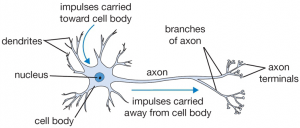
When the brain is exposed to stress the body begins to release cortisol which is the primary stress hormone. This chemical affects your heart, lungs, skin, immune system and circulation. In addition, it stimulates the hypothalamus and when it reaches the neuron, it shuts off the impulses of the dendrites which halts learning. This is a temporary response and the dendrites will grow back UNLESS there is a long term period of stress. When stress is repetitive the brain will respond by short circuiting that pathway which will stop impulses and result in the lack of input and messaging.
Many of our students are in a constant state of stress from instability at home, lack of confidence in a subject, poor self-esteem, and relationships with their peers, etc. This constant state of stress causes inability to stay on task, inattention, and lack of self control.
The AHA Moment—students in a constant state of stress not only struggle with attention but their brain is actually inhibited from learning due too much or little cortisol.
Symptoms of Chronic Stress:
| Symptom |
Examples |
| Physical |
fatigue, headaches, muscle and joint pain, grinding teeth, stomach problems |
| Cognitive |
inattention, lack of concentration, blaming others, poor problem solving |
| Behavioral |
loss of appetite, withdrawal, acting out, tantrums |
| Emotional |
anxiety, guilt, irritability, uncertainty |
| Physiological |
Increase in blood pressure, breathing, heart rate and muscle tension |
Looking at the chart above, do you recognize any of your students?
Here are Five Ideas. Try to implement one this week!
- Get Active: Integrated movement where you cross the midline of the brain hemispheres will promote a better emotional state. 2-5 minutes before a test or activity where students need to have a clear mind try this site called Go Noodle (https://www.gonoodle.com/). It is free and provides active online videos to help your students get moving AND de-stress. By crossing the lateral line of your brain with movement helps to remove the survival reaction of your brain to a more focused state.
Example of a video found on Go Noodle: https://www.youtube.com/watch?v=jvgYsbDDZW8
- Breathing: Remember when someone is under stress, they produce cortisol which is impeding the brain’s ability to learn. By adjusting a person’s breathing while under stress, signals reaction and stops or shifts the production of cortisol. You can pair deep breathing activities with a calming visual which deepens the body’s ability to calm the mind and emotions. The benefits of deep breathing includes more oxygen circulating to the body, cleanses the body of toxic stress chemicals such as cortisol, and begins to refocus attention and clear thinking.
You can access this handout (calm_breathing) for ways to teach deep breathing with your students. Here are basic guidelines:
- Take a slow breath in through the nose (for about 4 seconds)
- Hold your breath for 1 or 2 seconds
- Exhale slowly through the mouth (over about 4 seconds)
- Wait 2-3 seconds before taking another breath (5-7 seconds for teenagers)
- Repeat for at least 5 to 10 breaths
*You can access a calming visual through www.calm.com
3. Model and practice the “Take 5 Technique.”
When students are filled with frustration due to anxiety the “Take 5” strategy is a easy visual to say—STOP and Think. This strategy allows you to help the child begin an inner dialogue about how to calm down while de-escalating the situation. Breathing or counting is a way to help regulate the brain and stop the focus on the anxiety or emotion that is stopping the dendrites to fire. Students truly do “stop thinking” when in a state of stress or reaction. Helping them to learn ways to handle this stress will help them learn how to regulate the body. Click here for a printable version of this technique from: www.childhood101.com.
4. Ball Toss or Silent Ball: Tossing the ball or even the movement of watching someone else, will lower cortisol levels. This movement increases a student’s ability to focus and concentrate. As a teacher you can use the ball as part of your instruction during the question and answer part of your lesson. The movement of the ball helps to refocus all students and the unknown of where it will be thrown increases concentration and engagement. You can also play a ball toss game or Silent Ball for a few minutes (recommendation no more than 6 minutes) before a difficult task to heighten “good stress” by increasing the adrenaline of your students but not overwhelming them.
Click here for directions on Silent Ball: silent ball
5. Lazy Eight: A figure eight pattern will increase thinking and eye movement across the midline of your brain and create coordinated movements. These movements activate the entire brain and the repetition resets neural connections.You can have students take a scrap piece of paper and draw a figure 8 (see diagram below) for 30 seconds continue to retrace. Have students switch to the other hand and continue to draw and trace the pattern for 30 seconds. Continue to switch hands and draw for a total of 2 minutes. Another version of the Lazy Eight is for students to physically stand and use their arms extended to move in a figure 8 pattern and move from side to side as you would if you were drawing the pattern.
 Demonstration here at Youtube
Demonstration here at Youtube
In days ahead, we are faced with the challenge to keep students as free from stress while learning. Remember, for the brain to function, the hypothalamus must be regulated in a stable or regular state. Deep breathing, active moving, and using calming visuals will help the brain stop making cortisol which impedes learning and thinking. Learning how to manage feelings of stress is a life long lesson and if we model and practice these skills for our students—they will become healthier AND more engaged in our classrooms. Who knows—maybe we will learn a thing or two along the way!
Resources accessed for this article:
Article by Marian Wilde accessed on March 15, 2016: http://www.greatschools.org/gk/articles/stressed-out-kids/
Statistics accessed on March 15, 2016: http://www.nimh.nih.gov/health/statistics/prevalence/major-depression-among-adolescents.shtml
